On droughts and dry spells… notes from the Gibber Country
Following is an extract from the garden talk I delivered to the Walgett Gardeners in the beautiful garden of Loretta and Greg Robinson at Wonga, south of Walgett last weekend. It was an interesting and inspiring morning spent with Jerry Coleby-Williams discussing the challenges for all of us as we adapt to our changing and sometimes challenging climatic conditions. My sincere thanks to North West Health and other groups for their support of this day and to Denielle and Kate and fellow Walgett gardeners who listened with such patience, generally when I have something to say there is no one around to hear it! Best of luck to the Walgett Garden Club initiative, may your gardens bloom and your gatherings be fruitful and fun.
The Oxford Dictionary defines Gibber Plains, or country in this instance, as an arid stony area of low relief in which stones form the surface layer. From experience I would add they also form plenty of underlying layers though one must draw comfort from it having some relief, even if it is rated as low.
Hello, I am Kylie Rutledge and I have shifted a bit of gibber in my time; possibly enough for Gina Rinehart to consider me as some sort of low carbon footprint mining option and how flattering that would be, I am always looking for an opportunity to offset my assets. I would like to welcome you into my garden at Moble today, in the heart of the Gibber Country.
So where to start …
Moble is situated south west of Quilpie, 1000km west of Brisbane in a region recognised as the Eastern Channel country.
Our home is nestled on the southern side of TU Creek and the waterhole is the heart of our garden. Our lives are directed by its rhythm and flows: it is the backdrop to the drama that is family life. Our children have learnt to swim in it, flung themselves into its cold depths from the overhanging trees, built their cubbies on its banks, rowed their boats upon it and sunk their rafts into it. It is a constant in our lives: there to welcome us home, calms and restores us and now and then reminds us that nature is the Boss! When I walk down the verandah in the morning, I see the day ahead reflected in its surface, mostly it welcomes me.
We have lived on our creek now for thirty-four years and are fortunate that Brian had the foresight to dig out and extend the waterhole to begin with, having lived here all his life he knew the importance of water, water, water. The garden inventory then consisted of a little cottage surrounded by a high netting fence sagging with frosted antignon, enclosing a postage stamp of dry couch grass with a white oleander near the outside toilet. Looking back, these seem humble beginnings indeed, especially as the little cottage had been used as a feed shed for some years and came fully stocked the associated residents.
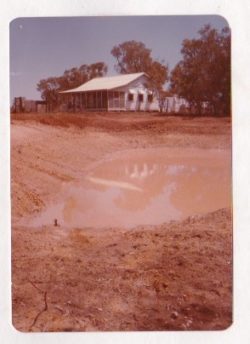
However, we were neither daunted nor concerned; rather we had a blank canvas on which we could splash about our own ideas and I was determined to keep that canvas a minimalist one, for I was not to be tied to a garden.
Gardening to me seemed an endless chore carried out by the older people of my family and occasionally inflicted on youth as required. My experience totalled weeding and raking, both I regarded as punishment. I well remember the first time I mowed the lawn after I was married, Brian introducing me to the old temperamental lawn mower, always wheezing and coughing. After finally starting it, I would be madly dashing about over uneven grass with gibber shooting out when the blades were set too low. Chopped out mower blades, broken tines of garden forks and broken handles on shovels are all testament to the challenge that is gardening in the gibber.
I soon realised that to have a beautiful garden around you, something we had both grown up with, you had to get in and garden, so when Brian suggested we plant some roses I discovered the exciting and tantalising world of plant catalogues. This coincided with the gift of an Edna Walling book and there was no turning back. A Gardener’s Log still inspires me and taught me to look to the bush around me for inspiration. Whilst it is important to protect against the extremes of our climate, I believe we must also embrace the beauty that surrounds us, it is there if we look for it.
On Gardens
I have no idea of the size of our garden now, but the fence has not been expanded for some years. I think this is because it is just a little too large to keep watered in the heat and a nightmare for anyone else to caretake. Brian once told me there was no need to build another garden fence as we had a perfectly good boundary fence on Moble; having just completed 105kms of exclusion fence with him, I totally agree.
There are always new ideas brewing though, the result of too much time spent behind mobs of sheep dreaming up elaborate plans. These soon fly out of my head when I return home and am faced with the reality of what is, instead of what it could be. But then to garden is to dream.
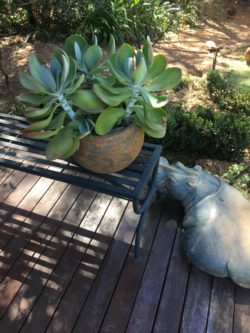
Gardeners from all over describe their climatic conditions as harsh or tough, no matter where they live. I believe that it is all relative and we live where we live so we must just get on and garden accordingly as best we can.
Our summers are hot and it is the minimum temperatures that thwart you, not the maximum but we don’t have the freezing winters that others endure. So, we mulch up for the summer and put our gardens to bed just as someone further south may against a harsh winter.
Our average rainfall is 300mm which falls sporadically rather than in seasons, so we have always managed for the dry. Possibly summer weighted, we are too far south for a Summer Wet as such and the average is gleaned from below 100mm to a record high in 2010 of 859mm. I have recently written up our rainfall records from 1924 and one of our girls charted the graph. It resembled someone having a heart attack which is probably quite accurate. Since we were married in the mid 80’s we have had a record dry and a record wet year, and both have illustrated the charm of an average life, though mud grows grass and dust doesn’t.
At Moble I have the luxury of an automatic watering system and three pressure pumps which has allowed me to extend the garden beyond what would be possible if I was still shifting hoses all day and night. Even so, sometimes in summer I think the garden resembles an emergency triage station, with me striding around, hose in hand saying “You look like you’ll get through, I’ll see you tomorrow “or “Right, hold my hand and drink deeply now”.
Like all gardeners, I yearn to grow plants that do not suit my climate and I have tried many over the years and still do. Sometimes it is surprising what will grow, especially once the soil and micro-climate are improved. I am by no means a technical gardener, I am by nature a slattern and therefore not good with regimes. Having said this, I cannot walk past a pile of manure without putting it on the garden and almost all green matter goes back into the beds.
My grandmother’s gift of a tin of earthworms for the garden opened my eyes to the wonder of soil. I have really tried over the years to improve the soil in my garden but alas, it is still far from ideal.
The garden at Moble has grown as the house has been added to over the years and our little cottage is now a rambling country home that I once described as being held together with cobwebs and dust. We are fortunate that much of the house is only one room deep which affords plenty of light and views to the garden. When the windows are clean most of them frame a pleasing picture, so I never feel I am out of the garden.
Our garden has played host to those milestones in our lives: our girls were christened in it with water from the creek, we have celebrated birthdays, anniversaries, weddings and pretty much any other excuse for a party within its fold. It has been a nursery for the children’s endless and unusual menagerie and despite loud noise and wild nights, still it manages to smile.
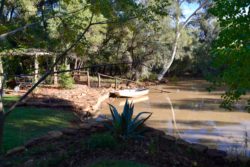
On Drought
As I believe I am now known as the Drought Specialist, something I am not entirely comfortable with, I had better talk about gardening in a drought.
When I reflect on drought, I firstly think of how insidious it is. Drought creeps up and slowly envelops you. It smothers you in its smell and cloaks you with tiredness. Drought is limiting and relentless, it has no charm and bears no favours.
There is no day when you think, Oh, righto, we’re in drought.
Rather there is that slow realisation that another month has slipped past without relief or an important date which you have been looking to, such as Christmas, Easter, a birthday, come and go in a blur.
So, you re-adjust, re-calculate and try to look ahead. Always looking ahead.
I recall some lines from a piece of poetry our daughter Felicity wrote in her senior year in 2004:
And all around the harsh reality
Summed in dead trees naked clarity
Summed in every pile of bones
Summed in every calf alone.
We have an excellent water supply at Moble which we maintain fastidiously but even so, in the summer of 2013/14 our waterhole dried up for the first time. I have gardening friends who have run out of water from time to time and I could never imagine the desperation they must feel. When it did happen to us, I recall it as being just one more layer in the Fresh Hell Trifle that was served up that summer.
In hindsight, the garden was severely stressed at least two months before we ran dry. The big old waterhole was a series of putrid puddles and when I sent the water to be tested after some animals became unwell, they pretty much said it was off the scale salt mineral poison. I think radioactive was the only adjective missing. It burnt your skin to touch and this is what we were seeing in the garden. At that time, we had no bore water as back up, so when Brian turned the pressure pump off that was it for about five weeks.
The famous English gardener Vita Sackville-West wrote, “The most noteworthy thing about gardeners is that they are always optimistic, always enterprising, and never satisfied. They always look forward to doing something better”. She pondered on that over one hundred years ago in England and yet these words still stand true and I think describe my approach to gardening in a drought in western Queensland today.
Like a Machiavellian Queen of the Dust, I plotted and planned my garden’s return throughout that time.
Drought feeding has one advantage, hay and manure in herculean quantities and a great deal of this went onto the now empty garden beds. With no lawns to constrain me, it was easy to re-align and re-design. I made lists, drew and re-drew plans and sketches, striding out areas to work out how quantities, muttering, reading and researching. This afforded a tremendous focus throughout that time and allowed me to dream rather than see what was in front of me. I am very adept at squinting to blur the edges of my life, there is plenty of time for clarity when it has rained.
The hardest losses from that time were our established trees, and I still feel their loss in the garden now. They were old friends. They filled in patches of endless sky and welcomed you into their delightful shaded rooms.
We lost most of the garden except for all the plants I was told as a young bride to plant as nothing else grows at Quilpie…
Bougainvillea, oleander, eucalypts and olives.
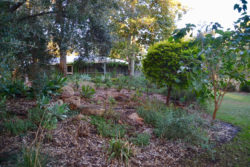
Some other survivors were:
The Mile a Minute (Mikania micrantha) on the tennis court survived and for a while there I even liked it!
The Tweediana, Cat’s Claw Creeper, which I had been systematically poisoning for years survived and still flowers in a yellow blaze, we have come to terms with each other. You will note that many plants that thrive in Quilpie district are on the WONS.
The Celtis and White Cedar trees survived.
A Chinese Pistachio which always struggled at the end of a dripper line survived and is now wonderful, so maybe its years of struggle helped it through. The Petreas at the front gate survived growing in similar circumstances.
Although they looked dead, the durantas and plumbago subsequently re -shot in some areas.
Many trees that seemed to have survived in the first instance have since had to be pulled out as they just didn’t recover or were badly affected by borers that obviously prey on stressed systems.
As you can imagine, when the waterhole filled, I hit the ground running. Clearing out the dead garden was a massive job, we carted away truckloads of dead trees and garden. I found it difficult deciding initially what to cut back and what to pull out and agonised over some areas. When in doubt, I gave it a season’s grace.
Trees were planted next and I have planted more formal hedges this time, most of them white duranta, murraya, The Pinkilla Hedge Clerodendrum heterophyllum and privet. This was to quickly provide some form and shape again and it was a good decision. Within 12-18 months the combination of the existing rock walls, the hedges and the ever-present squinting gave the illusion of the shape of a garden again.
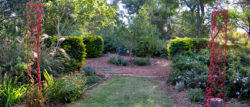
The hedges have since proved their worth as we have battled ensuing years of dry and unprecedented kangaroo numbers. Kangaroos are not a gardener’s friend alas with their daunting skill set of ringbarking, stripping and trampling. It is hard to control them at Moble as they can swim the waterhole and every morning reveals new devastation within. So, while the perennials et al have once again disappeared, at least we still have the hedges in- tact.
I would like to applaud Iceberg roses here, whom like Iceberg lettuce and shoulder pads were big in the 80’s and for some reason fell out of fashion. I re-planted a hedge of them outside our large bedroom window and cannot imagine what else would give so much for so little. I think of them like White Costello cheese, you might try other fashionable selections, but you will always come back to both!
The recovery and return of our garden were by no means smooth or easy. As farmers, you are probably all very aware of your soil condition. I had vastly underestimated the drought impact on my soil and after some months of frustration and little growth and still no lawns, I tested it and found we had a pH of 9.5. Armed with knowledge, a powerful accessory for any occasion, I then set about hand digging in bags of sulphur and have been diligent with my sulphur inclusive fertiliser regime ever since.
The years since 2014 have not been ideal and when I wrote this, I was playing the Rain by Easter game. We have recorded 99mm rain in the twelvemonth period up until my writing this in the last week of March and experienced a fairly solid summer. All things considered, the Moble garden looks in reasonable shape. It is bare of adornment as such but well mulched and ready for the rain.
Added clause: 57mm rain fell over two days 27/28thMarch, best rain since March 2014.
I applaud the generosity of my fellow gardeners, after it rained, I was overwhelmed and will be forever thankful for the kindness and largesse of many of my friends and also people whom I barely knew, who passed on cuttings from their gardens. I have Diana’s Aggies, Jan’s Teucrium, Annie’s Iris, the list goes on. I love having them with me in the garden, they are life’s treasures. It is also exciting to visit gardens elsewhere and remember plants that I once grew and had forgotten about. It is even more exciting when I can recall them afterwards and remember to plant them again!
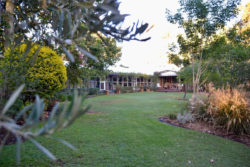
I shall give you my lessons from a Drought Gardener…
- Test your water and understand the implications of it so you can use it to best effect. This will allow you to know what you can do to counter-act any problems the water may generate. The devil you know…
- Test your soil and understand the implications of it as well. Most problems can be remedied but also suitable plants for your soil will mean less heart break and frustration. The devil you know…
- Use Gypsum and mulch, mulch and mulch.
- Check your irrigation set up and make sure your watering system is working as best it can, so you have no wastage and are watering effectively.
- I don’t cut back anything in the heat, I wait until it is cooler and/or has rained so the plant can benefit from the new growth the pruning stimulates. I also see no point in creating new growth to feed the kangaroos and rabbits. The same for fertilising, unless conditions are good for growth, hold back.
- Don’t forget the old stalwarts…oleanders, bougainvillea etc are glamorous and very undemanding. A deep planting of olives with bougainvillea left to grow as a shrub will form a tough screen for dust and heat and a wonderful bird habitat. Many of the older varieties are tougher than the newer models… I found that with my ornamental grapevine. See what survives around old homesteads and plant that.
- Be kind on yourself and to those around you, drought is a no- fault situation.
- Use the opportunity to assess your garden with new eyes, what works and what doesn’t.
- When I am having a bad drought day, perhaps undertaking a less than charming task, I channel Winston Churchill’s ‘this too shall pass’. I can sometimes recite this for days in my mind.
- For me personally, I tend to do a great deal of squinting to blur the edges, which some have said will have long term implications on my complexion. I also drink a great deal of Gin, which I believe won’t.
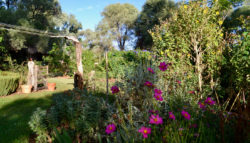
A final observation on drought: To me, drought is like childbirth, and I have been through my share of them as well. Once it is over you really can’t remember all the pain and anguish in detail, despite it being etched on your face. Our minds have a powerful way of coping and that is to blur and to forget, until next time.
Rather like childbirth, after the drought you have the elation of new life bursting forth and to witness the re-birth of your country with such incredible vigour, all the plants and all the animals, there en-masse before you, well you wouldn’t miss that for anything. For months after a dry spell, I find myself just standing and gazing, it’s like taking in a lung full of air after being underwater. There you are, those are my reflections on gardening in the drought.
Brian and I feel very lucky to have been here with you all and to share in your gardening journeys.
© Kylie Rutledge 20 March 2019
Quilpie Garden Suggestions
The bold denotes that this plant may be suitable for bore water however, as no two bores are the same, it will be trial and error to see what suits your particular bore water.
Trees
Bauhinia Bauhinia blackeana, B.varigata, B. alba
Bottlebrush Callistamen spp
Bottle Tree Brachychiton australis
Buddlieia Buddleia spp
Chinese pistachio Pistacia chinensis
Chinese Elm Ulmus parvifolia
Chinese tallow tree Sapium sebiferum
Celtis Celtis spp
Claret Ash Fraxinus oxycarpa
Date Palm Phoenix canariensis
Fig Ficus macrocarpaand other ficus spp
Crepe myrtle Largerstroemia indica
Cotton Trees Hibiscus tileaceus
Frangipani
Golden Shower Cassia fistula
Eucalyptus spp
Indian Siris Tree Albizia lebbeck
Jacaranda Jacaranda mimosifolia
Lily Pily Eugenia spp
Kurrajong Brachychiton populneus
Melaleuca leucadendra and other Melaleuca spp
Mulberry Morusspp
Olive Olea europaea
Drunken Parrot Tee Schotia Brachypetala
Pepperina Schinus molle
Yellow Poinciana Peltophorum pterocarpum
Pomegranate Punica granatum
Silky Oak Grevillea robusta
Race Horse tree Tipuana tipu
Tabebuia Tree Tabebuia palmeri
White Cedar Melia azedarach
Shrubs
Bauhinia galpinii
Buddlieia Buddleia spp
Blue Potato Bush Lycianthes rantonnetii
Box Buxus microphylla
Pinkilla Hedge Clerodendron heterophyllum This hedge is as tough as Nanny’s knees!
Cotoneaster spp
Duranta spp great for hedges and topiary as well
Emu Bush Eremophila spp
Fiddlewood Citharexylum spinosum
Grevillea spp
Indian Hawthorn Rapheolepis spp
May Bush Spirea catoniensis
Mock orange Murraya paniculata
Oleander Nerium oleander
Photinia Photinia robusta
Plumbago Plumbago spp
Privet Ligustrum spp great hedge
Prunus spp
Russian Olive Elaeagnus spp
Vitex spp
Westringia spp
Climbers
Coral Bells Antignon leptopuswill frost
Banksia Rose
Blue Potato creeper Solanum wendlandii and alba for white
Bougainvilleas spp
Cat’s Claw Creeper Tweediana Invasive declared weed
Chinese Star Jasmine trachelospermum jasminoides
Honeysuckle Lonicera spp
Jasmine spp
Ornamental Grape Vitis sppfind an older variety for extra toughness
Petrea Petrea volubilisa drought buster!
Orange trumpet Vine Pyrostegia venusta
Quisqualis
Climbing Roses
Stephanotis floribunda
Virginia creeper Parthenocissus quinquefolia
Wisteria spp
Garden Perennials etc
Agastache spp
Aloes
Agapanthus
African daisy
Canna
Catmint Nepeta spp
Chrysanthemum
Crinum Lillies
Curry Plant Helichrysum
Cuphea
Day Lillies Hemerocallis spp
Pink Evening primrose Oenothera speciose
Grasses, Miscanthus spp, Penesetum spp,
Geraniums and pelargoniums
Hippeastrum Armaryllis spp
Iris
Lavender
Liriope
Sacred bamboo Nadina spp
Rosemary, thyme, Oregeno, Sage, Tarragon, Basil all make great fillers
Dog bane Plectranthus spp
Salvia spp
Seaside daisy Eriginon karvinskianus
Succulents varied, I find many don’t love the heat but have a go!
Roses if you have good water
Teucrium
Wormwood Artemisia spp



